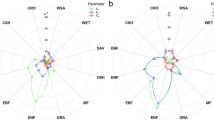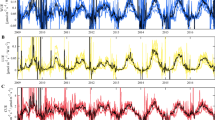Abstract
The widely performed Bayesian synthesis inversion method (BSIM) utilizes prior carbon flux and atmospheric carbon dioxide observations to optimize the unknown flux. The prior flux is usually computed from ecological models with large biases. The BSIM is useful in solving the problem of insufficient data, but it will increase the inaccuracies in the estimates caused by the biased prior flux. In this study, we propose a dual optimization method (DOM) to introduce a set of scaling factors as new state variables to correct for the prior flux according to information on plant functional types. The DOM estimates the scaling factors and carbon flux simultaneously by minimizing the cost function. The statistical properties of the DOM, which compare favorably with the BSIM, are provided in this article. We tested the DOM through simulation experiments which represent a true ecosystem. The results, according to the root mean squared error, show that the DOM has a higher accuracy than the BSIM in flux estimates.

Similar content being viewed by others
References
Denman KL, Brasseur G, Chidthaisong A et al (2007) Couplings between changes in the climate system and biogeochemistry. In: Solomon S, Qin D, Manning M et al (eds) Climate change 2007: the physical science basis. Cambridge University Press, Cambridge, pp 499–587
Enting I, Trudinger C, Francey R (1994) A synthesis inversion of the concentration and δ 13C of atmospheric CO2. Tellus B Chem Phys Meteorol 47:35–52
Fan S, Gloor M, Mahlman J et al (1998) A large terrestrial carbon sink in North America implied by atmospheric and oceanic carbon dioxide data and models. Science 282:442–446
Bousquet P, Peylin P, Ciais P et al (2000) Regional changes in carbon dioxide fluxes of land and oceans since 1980. Science 290:1342–1346
Enting IG (2002) Estimation. In: Dessler AJ, Houghton JT, Rycroft MJ (eds) Inverse problems in atmospheric constituent transport. Cambridge University Press, New York, pp 41–60
Gurney KR, Law RM, Denning AS et al (2002) Towards robust regional estimates of sources and sinks using atmospheric transport models. Nature 415:626–630
Rodenbeck C, Houweling S, Gloor M et al (2003) CO2 flux history 1982–2001 inferred from atmospheric data using a global inversion of atmospheric transport. Atmos Chem Phys 3:1919–1964
Michalak A, Bruhwiler T, Tans P (2004) A geostatistical approach to surface flux estimates of atmospheric trace gases. J Geophys Res 109:1–19
Deng F, Chen JM, Ishizawa M et al (2007) Global monthly CO2 flux inversion with a focus over North America. Tellus B Chem Phys Meteorol 59:179–190
Deng F, Chen JM (2011) Recent global CO2 flux inferred from atmospheric CO2 observations and its regional analyses. Biogeosci Discuss 8:3263–3281
Peters W, Jacobson AR, Sweeney C et al (2007) An atmospheric perspective on North American carbon dioxide exchange: CarbonTracker. Proc Natl Acad Sci USA 104:18925–18930
Masarie KA, Petron G, Andrews A et al (2011) Impact of CO2 measurement bias on CarbonTracker surface flux estimates. J Geophys Res 116:D17305
Zupanski D, Denning AS, Uliasz M et al (2007) Carbon flux bias estimation employing maximum likelihood ensemble filter (MLEF). J Geophys Res 112:D17107
Schuh AE, Denning AS, Uliasz M et al (2009) Seeing the forest through the trees: recovering large-scale carbon flux biases in the midst of small-scale variability. J Geophys Res 114:G03007
Schuh AE, Denning AS, Cornin KD et al (2010) A regional high-resolution carbon flux inversion of North America for 2004. Biogeosciences 7:1625–1644
Lokupitiya RS, Zupanski D, Denning AS et al (2008) Estimation of global CO2 fluxes at regional scale using the maximum likelihood ensemble filter. J Geophys Res 113:D20110
Thornton PE, Law BE, Gholz HL et al (2002) Modeling and measuring the effects of disturbance history and climate on carbon and water budgets in evergreen needleleaf for forests. Agric For Meteorol 113:185–222
Melillo JM, Mcguire AD (1993) Global climate change and terrestrial net primary production. Nature 363:234–240
Liu J, Chen JM, Cihlar J et al (1997) A process-based boreal ecosystem productivity simulator using remote sensing inputs. Remote Sens Environ 62:158–175
Maksyutov S, Inoue G (2000) Vertical profiles of radon and CO2 simulated by the global atmospheric transport model. In: Shimizu H, Takeuchi T, Miyabe T et al (eds) CGER supercomputer activity report, vol 7. CGER, NIES, Japan, pp 39–41
Acknowledgments
This work was supported by the Key Global Change Program of the Chinese Ministry of Science and Technology (2010 CB950703). Dr. Feng Deng of the University of Toronto provided valuable assistance in using the transport and error matrixes used in this study.
Author information
Authors and Affiliations
Corresponding author
About this article
Cite this article
Zheng, H., Li, Y., Chen, J. et al. Applying a dual optimization method to quantify carbon fluxes: recent progress in carbon flux inversion. Chin. Sci. Bull. 59, 222–226 (2014). https://doi.org/10.1007/s11434-013-0016-5
Received:
Accepted:
Published:
Issue Date:
DOI: https://doi.org/10.1007/s11434-013-0016-5




